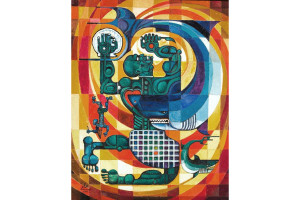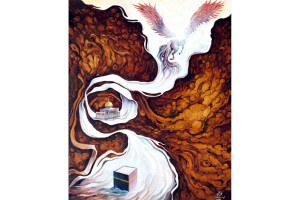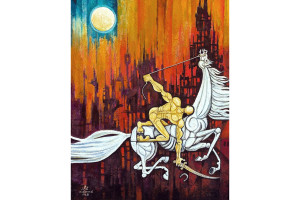Art from the heart
BEING a legend in his own time hasn't slowed Abdulla Al Muharraqi form his harried working pace of sketching two cartoons daily for the press, preparing for local and overseas art exhibitions, continuing on his latest canvas of a scene from the Arabia of bygone days or welcoming guests into his own gallery.
The name Muharraqi is arguably the most well known among the far over a hundred artists in Bahrain and has become virtually a household word.
His works - whether in romantic realisism or simple cubism - reflect a style that's instantly recognisable by art connaisseurs. His dramatic rendering of a folk tale of a beautiful sorceress with the leg of a donkey and fanglike finger nails is enough to leave the casual viewer's mouth agape.
Though he loves experimenting with modern techniques, ideas and methods, Al Muharraqi's opposed "to just putting circles and squares on a canvas" in an abstract form. "When you view some abstract paintings, they could be from anywhere or any painter.
"Whether realist, cubist or surrealist, I want my painting to reflect the feeling I have for my country. I'm a part of this land, and my art must not be far from my artistic expression. Like a tree, roots are very important.
"If you cut down the tree, the roots will decay but there'll be no fruit." Although born in Manama, Abdulla's schoolmates referred to him as a Muharraqi as his parents hailed from the island which once was the seat of government and is today dominated by the international airport.
At school, teachers recognised his talents early for drawing at a time when art classes were still new to the curriculum. By the age of 12, Abdulla had won his first prize in art. The school principal called Abdulla to his office.
The youngster wondered a bit worriedly what it was all about. "You seem to be quite good at drawing, Abdulla", the principal said with an unconcealed smile of pride on his face, the student relieved to know that the talk with the principal wasn't a reprimand or scolding.
"There's to be an art contest, and we'd like you to enter it by painting a portrait of His Highness the Amir." A huge photo of then Ruler Shaikh Salman bin Hamad Al Khalifa, larger than Abdulla, was loaned to the student which he could use to paint his portrait in oil. The budding artist was undaunted by the task his principal gave to him. The work of art was produced and judged. To Abdulla's amazement he won the competition and won the princely sum of 135 rupees - over BD 13 and quite a handsome amount for a 12-year-old in the Bahrain of the 1950s.
A couple years later, an official of Bahrain Petroleum Company approached the teenager and asked whether he could do a series of paintings, both on scenes from Bahr-ain and workmen at the refinery. Recently, when Mr. Al Muharraqi was in the Bapco offices, he was overcome by melancholy as he noticed one of his teenage paintings hanging in a reception hall from his first commissioning.
Later the company asked him to sketch cartoons which would emphasise employee-safety concerns. In 1998, the corporate calendar features the artist's more recent works.
While most people relate immediately to Al Muharraqi's endearing scenes of Arabia - the horses, village and market scenes, landscapes, dhows - he says that the symbolic, surrealistic style "is nearer to my heart". Over the past decades, Al Muharraqi's style has evolved and matured.
His works employing simple cubism retain a classic feel abut them while giving a modern touch to the artistic expression. The stark, social comment on canvas of children's starvation in other regions of the world are paintings to ponder.
The first thing he does when he gets up in the morning is to turn on B.B.C.'s Arabic service to absorb the day's developments in the world but particularly in the Middle East. Some events anger him and cause his blood pressure to rise but he immediately begins to sketch a few ideas for the next day's editions of Akhbar al Khaleej and Sharjah's al Bayan.
Reported political crises and social confrontations often find Muharraqi emotionally distraught. But after a few hours at the drawing board, his editorial-page cartoons have translated his emotions, often into a bittersweet humour, and the artist finds himself at peace again, having wrestled with expressing a political, social or economic absurdity through his drawing pen.
Local readers have delighted in the cartoonist's sometimes ascerbic, sometimes piquant or poignant views of personalities and events in the regional and global arena in the daily paper for the past more than 20 years. Once Muharraqi later additionally did a daily cartoon for al Bayan, his renown went far beyond the gulf shores.
Art's very important in a school curriculum, and now there's even a degree in art in Bahrain schools. Muharraqi pegs 1935 as the year that art came to Bahrain in the form of an Egyptian teacher who helped pupils to see drawing as a viable artistic expression.
As a youngster, Abdulla was taken by the paintings and drawings hanging on the walls of classrooms, scenes of life near and far. "If any young person today wishes to pursue a career in art and design, he must be ready to work hard, study techniques, learn the basics and buy books which illustrate various art styles.
"The human body's very important, and the artist must understand how to draw it." Egyptian art first captured Muharraqi's attention when he studied at the Faculty of Fine Arts in Cairo.
Through classroom study, he then discovered the styles of Michelangelo and Goya that inspired him. At 28 years of age, he received his master's in decorative arts from the University of Damascus.
The Bahraini aritst's own works have been exhibited in Algeria, Egypt, France, Italy, Iraq, Korea, Kuwait, Oman, Qatar, Spain and the United Arab Emirates. Honouring the renowned artist, the Qatar National Museum has now created a Muharraqi hall to show off some of the works of the painter.
Recent commissionings have included dramatic murals in Riyadh (6x25') and at the Bahrain Defence Force headquarters (12x18') to depict vignettes of Arabian life. On occasion, Muharraqi's been called upon to do portraits of personalities at home and abroad.
Having now done portraits of most of the rulers in the Arabian Gulf, the Bahraini artist has done portraits of such celebrities as Queen Elizabeth II and former French president Giscard d'Estaing, works that Muharraqi personally presented to the leaders. Though he started out in interior decorating, Muharraqi switched to painting virtually full time once it seemed that sketches and oils could occupy him in the studio sometimes day and night.








